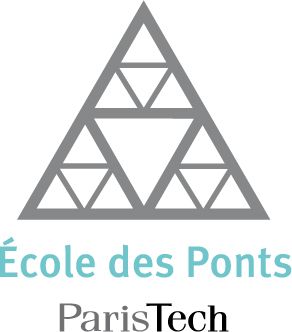Multiphase modelling
Group leader : Karine Kata-Sartelet
The activity of the group is focused on the development and the validation of two multiphase models that are coupled to the three dimensional host models Polair3D and Mercure_Saturne. The two multiphase models mostly differ in the discretization of the size distribution of aerosols: log-normal distribution for MAM (Modal Aerosol Model) and size-resolved distribution for SIREAM (Size Resolved Aerosol Model).
The MAM and SIREAM models
The models MAM and SIREAM describe the time evolution of the aerosol distribution in a box under nucleation, condensation/evaporation and brownian coagulation. The aerosol size distribution is made of four log-normal modes in MAM and of a specified number of sections in SIREAM, with diameters typically ranging from 0.01µm to 10µm. The assumption of internal mixing is made (to each size corresponds a unique chemical composition). The species are inorganic (on the basis of the thermodynamic models ISORROPIA or EQSAM: sodium, ammonium, sulfate, nitrate and chloride), organic (primary organic aerosols and parameterized representation of Secondary Organic Aerosols with two-product formulations), inert (mineral dust and Black Carbon) and water. Parameterizations are used to model binary nucleation (sulfuric acid and water) and ternary nucleation (sulfuric acid, ammonia and water).
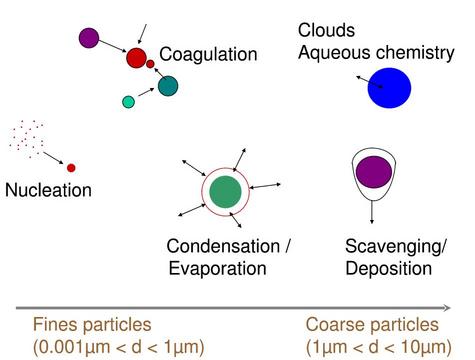
The different processes that influence the composition and the size-distribution of aerosols.
Condensation/Evaporation
Condensation/evaporation is a key process for the aerosol composition and distribution. Gaseous species may condense onto existing aerosols, or species in the aerosol phase may evaporate. This mass transfer between the aerosol and the gaseous phases depends on the difference of concentrations of gaseous species far from aerosols and the concentrations of gaseous species at the surface of aerosols (which are assumed to be at local thermodynamic equilibrium with the aerosol internal composition). Mass transfer can be computed dynamically, or by assuming thermodynamic equilibrium between the gaseous species far from aerosols and the internal aerosol composition. As dynamical mass transfer requires a lot of computing time compared to thermodynamic equilibrium and as the assumption of thermodynamic equilibrium may not be accurate for large aerosols, a hybrid approach has also been developed: thermodynamic equilibrium is assumed for small size aerosols and dynamic mass transfer is computed for large aerosols.Numerical aspects
Many appropriate algorithms have been developed and/or used for the numerical simulation of the GDE, ranging from stochastic mass flux methods to lagrangian methods, collocation or variational formulations. Specific mode merging and splitting have been developed in MAM to force modes to be of distinct size ranges throughout the simulations. New algorithms have been proposed for the redistribution of aerosol lagrangian bins on a fixed grid.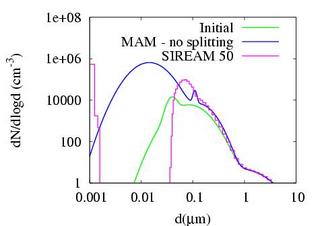

Comparison of the number distribution during a high-nucleation episode with MAM (with or without mode splitting) and SIREAM (15 or 50 sections).
Aqueous-phase chemistry and heterogeneous reactions
Further developments have concerned the aqueous phase of aerosols by adaptating the cloud model VSRM (Variable Size-Resolved Model, Carneggie Mellon University). This work is a follow-up of works devoted to the numerical modelling of aqueous-phase chemistry. Inorganic heterogeneous reactions at the surface of aerosols have also been studied. They may have a significant impact on gaseous photochemistry and particles, especially for nitrate.3D parameterizations for aerosol modelling
To couple the 3D chemistry transport model Polair3D to the multiphase models SIREAM and MAM, other processes have been taken into account, such as dry deposition, below-cloud scavenging, the influence of the acidity of clouds for below-cloud scavenging, in-cloud scavenging and the treatment of emissions. Sea-salt emissions have been parameterized with specific approaches. The aerosol water content, which is used to compute the aerosol wet diameters, has been parameterized using an updated Gerber scheme. Specific works have been devoted to the parameterization of in-cloud and below-cloud scavenging for gases.Validation at regional/continental scales
The 3D chemistry transport model Polair3D, coupled to SIREAM, has been validated by comparison to data at continental scale over Europe, over Asia in the framework of the MICS project, at regional scale over Greater Paris, over Marseille in the framework of the ESCOMPTE campaign and over Lille. Polair3D-MAM has been validated by comparison to data at regional scale over Tokyo. Studies to assess the sensitivity of aerosol concentrations to different physical processes (coagulation, mass transfer, sea-salt emissions, aqueous chemistry and heterogeneous reactions) were performed over Asia in the framework of the MICS project, over Europe and at the regional scale over Paris.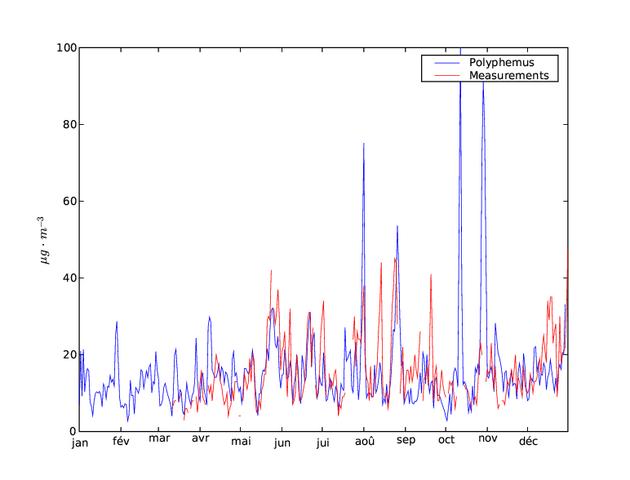
Comparison of PM10 concentrations at O Saviñao (Spain) during a europeen run for the year 2001.
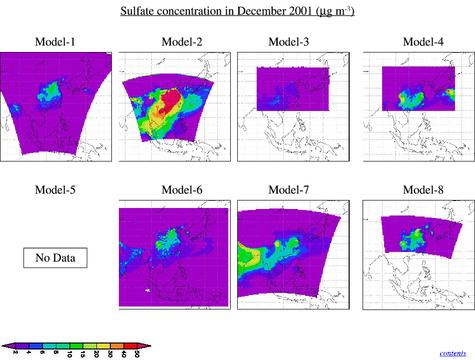
MICS project: comparison of eight models over Asia.
Local scale
At local scale, Polair3D-MAM is used to simulate aerosol formation and dispersion in the vicinity of roads. Traffic emission leads to high concentrations of sulphuric acid and to high nucleation events (ultra-fine particles of diameter around 1nm composed of H2SO4-NH3-H2O). Several measurement campaigns have put in evidence the rapid growth of the aerosol diameter close to a traffic source. Polair3D-MAM is used to try to reproduce the quick growth of these ultra-fine particles, and to identify the mechanism(s) responsible for this growth, e.g. condensation, coagulation, heterogeneous reactions of organic/inorganic species. MAM is also coupled to the model MERCURE-SATURNE for a more detailed study.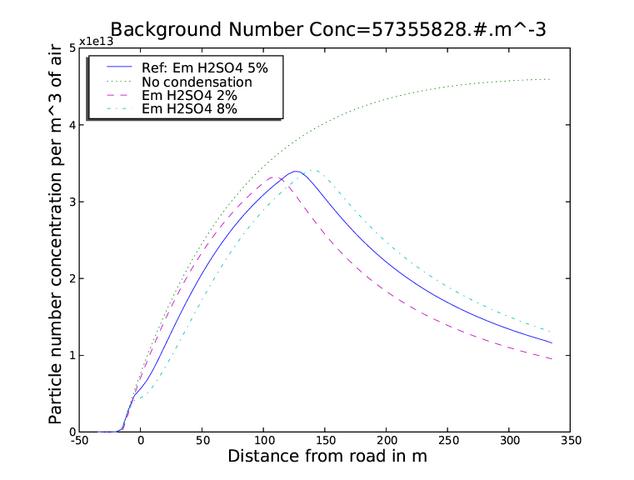
Variation of the number of particules with the distance to the road. A ternary parametrisation is used for nucleation (Napari).
